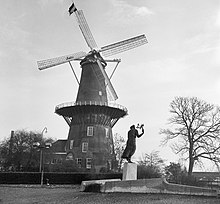Windmill sail
The jib sail is found in Mediterranean countries and consists of a simple triangle of cloth wound round a spar.Though rare in the UK, at least two windmills are known to have had jib sails (St Mary's, Isle of Scilly and Cann Mills, Melbury Abbas).[1] In 1860, the English millwright Catchpole fitted an automatic air brake to the ends of patent sails.Dekkerised sails provide enough surface area to be able to work the mill with no sailcloth spread if the wind is strong enough.The Bilau system uses sails with a streamline covering of the stock, coupled with a full length air brake on the trailing edge, together forming an airfoil.[2] It was invented by German airplane engineer Kurt Bilau early in the twentieth century and became quite popular in Germany where it was fitted to over 140 mills.[7] A similar system was invented by a millwright by the name of Van Riet of Goes where the leading edge and the airbrake together form a more complete airfoil.These sail positions are generally used by the miller to show for example a birth, marriage or death within his family or circle of friends but may occasionally also be used to show mourning at national events, for example the death of Prince Friso and during the day of national mourning for victims of the Malaysia Airlines Flight 17.[12] Sails are colloquially known as sweeps in Kent and Sussex, primarily due to the physical movement they perform and also that their construction does not necessarily involve sailcloth or canvas.

WindmillsreefingmedievalAndrew MeiklespringYorkshireBallycopeland WindmillNorthern IrelandWilliam CubittNetherlandsmillwrightsairfoilVordenleading edge slotGermanFranceFeltwellNorfolkHaverhillSuffolkBoxfordRoxwellCrux EastonHampshireQueen Wilhelmina of the NetherlandsPrince FrisoMalaysia Airlines Flight 17SussexDe Hollandsche Molen